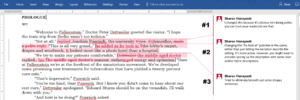Back in April, I offered to do a free sample edit for anyone who was interested in what it would be like to work with me and/or to see what it would be like to allow their manuscript to go under the knife. This week, DF Roberts contacted me and offered me the prologue to his novel The Scholars. He graciously agreed to let me share the edit here on my blog (which was part of the deal to get it for free), so let’s get started.
First, let’s talk for a minute about prologues in general. If they’re well done, there can be a place for them. Most of the time though, they are basically just “chapter 1” without the proper title, or they’re a backstory dump that the author thinks the reader needs to know right at the beginning of the story. Unfortunately, those backstory dumps can often turn a reader off in the first couple pages as they try to absorb all of this information that could have been more elegantly and smoothly incorporated into the story later on.
What about DF Roberts’ prologue? Because the prologue is all I got to see, I can’t answer definitively, but my gut tells me this is chapter 1.
OK … on to the first bit of actual editing. Now, if you’re new to seeing/using the track changes feature in Word, the screenshot below is what it looks like. The bigger column to the left is Roberts’ story (in the black text). Anything you see in red (and truly, my sincere apologies to any color-blind folks, of which my husband is one) is an edit of mine. Words in red that are struck-through are words I cut. Words that are only in red (and not struck-through) are words I either inserted or pasted after cutting them from somewhere else.
The smaller column to the right is where my comments appear with dashed red lines connecting to the highlighted areas of the original text that the comment is addressing.

Because this was the first time Roberts and I worked together, I explained a lot of my changes in the comments so that he’d know where I was coming from–what I was thinking when I hacked away at his story. I also thought it would be beneficial here on my blog.
So, looking at the comment I’ve labeled as #1:
Roberts had originally written: “Not at all,” Joachim Fuersich, the university Vice-Chancellor, made a polite reply.
I changed this to: “Not at all,” replied Joachim Fuersich, the university vice chancellor.
- Using “replied” instead of “made a reply” is less wordy and means the same thing.
- The dialogue makes it clear that Fuersich is being polite; you can trust your reader to see that/to know that without being told directly he’s being polite.
- Titles, such as “university vice chancellor,” aren’t capitalized (most of the time) unless they are used before the person’s name or in place of the person’s name (e.g., University Vice Chancellor Joachim Fuersich or “Not at all, Vice Chancellor”).
Comment #2:
Roberts wrote: “This is all very grand.” The lobby’s carpet, drapes and woodwork looked more like a plush hotel than a hospital.
I changed it to: “This is all very grand,” he added as he took in the lobby’s carpet, drapes and woodwork. It looked more like a plush hotel than a hospital.
- Notice in the screenshot that I brought this line up to be part of the same paragraph where Fuersich says, “Not at all.” He is continuing to speak, so there’s no need for a new paragraph, which Roberts had inserted.
- By adding “he added as he took in” after the spoken words and before the setting description, I’m putting Fuersich (and therefore the reader as well) more solidly in the scene. I’m letting the reader know that we’re seeing the room through Fuersich’s eyes. You want the reader there with the character. I also suggested in my comment to Roberts that he consider describing this more fully. What makes it “plush”? The colors? The fabrics? The details? All the above?
Comment #3:
Roberts wrote: “We try to make our patients comfortable,” Dettweiler replied. The middle-aged doctor’s manner radiated energy and optimism.
I changed it to: “We try to make our patients comfortable,” the middle-aged doctor replied, his manner radiating energy and optimism.
- These changes were about readability, about keeping the text flowing smoothly. Instead of leaving them as two separate sentences, I combined them to create one without changing the meaning or losing his context.
In my next post I’ll share more of the edits from Roberts’ prologue, a sample I thoroughly enjoyed. His character and conflict development are both strong, and I’m eager to see where the story goes. Hopefully, I’ll get the chance to work with him on it further.
Whether you are ready to discuss hiring me to edit your book or you’re interested in a free sample edit (which I can do only as my availability will allow me) to be shared here on my blog, please send me an email at sharon@editorsharonhoneycutt.com and let’s talk about your work.
Questions or comments about today’s post? Leave them below. I look forward to hearing from you!
Like this post? Please share it on Facebook, Twitter, or LinkedIn. Sign up for my newsletter if you’d like to know first when I publish a new writer-friendly blog post.
Thanks for stopping by!

0 Comments
1 Pingback